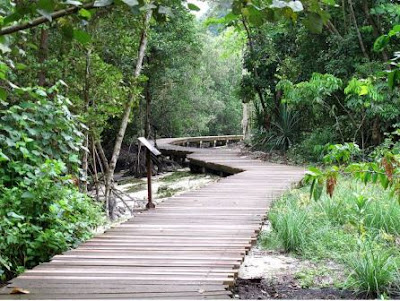Well, almost. Chose not to walk at Sungai Buloh with the birds on Monday morning, which I had been really looking forward to, stayed in bed instead. At Sungai Buloh they have just opened a free wireless interactive trail using webcams installed along the mangrove trail. Apparently you can access information on the wetland reserve by scanning the 20 different 2-D barcodes with your smartphone or tablet. You can then view content that is location-specific like listen to bird calls or observe behaviour of mudskippers through videos streamed over the wireless network. Its the first of its kind for Singapore and possibly the region. They didn't get to see this in action but Eric enjoyed the walk around the wetlands and saw some new bird species. Here he is with a few birds below, but they are the common ones.
I slept well and then went downstairs to the Tai Chi Meridian Reflexology Centre for a massage. Through the week I had given myself a sore neck, I think from a very vicious sneeze! By Sunday night it was completely locked up. Tai chi therapeutic massage focuses more on the pressure points and the redirection of the flow of chi than on the deep manipulation of muscles and tissues. It is said to restore proper flow of chi, not necessarily relaxation of the muscles, but that seems to happen too. It would seem physical relaxation is brought on by the opening of the meridians through which the chi will flow. Anyway, I was soon feeling so much better.
On Tuesday we met with the rest of the Great Race Committee to share what we have achieved so far and plan the next phase. This week at staff mtgs we offered the first round of points to be won. We hope to have the teams chomping at the bit by the time the actual Race Day arrives.
This morning at 5:30 we caught a taxi to Kranji War Memorial Cemetery, it was so early the temperature was pleasant and a full moon was still high in the sky. This is the first time either of us have ever attended a Dawn Service. There were 10 of us who ventured out so early from MAE and it was especially moving to attend alongside some New Zealand friends.
The service was presided over by Group Capt. Tim Walshe, NZ Defence Advisor and other dignitaries included HE Mr Philip Green, the Aust High Commissioner who read a poem and HE Mr H Taner Seben, the Turkish Ambassador who read the moving words of Ataturk. This brought back vivid memories of our day walking over the Gallipoli Peninsula in 2012. The Australian International School, Singapore provided the choir and Avondale Grammar School, another International School, provided the program and poppy distribution. At the conclusion all 1,000 of us invited to gather for gunfire breakfast where traditionally the coffee is served laced with rum. The trays and trays of finger food were so reminiscent of the food the Mess served at Butterworth; savoury mini pies, rolls and quiches. How they manage to serve all the guests amazes me, they always have enough yet there is no fixed number of people attending these functions.
After breakfast we joined a historical walk of the site guided by Wina from the Changi Museum. We found the half hour tour really interesting because Wina brought to life some of the stories of individuals buried here. Some were POWs, others died in the line of fire, either during WWII or later conflicts in the region. All of them were too young, all of them made enormous sacrifices for us. One very moving epitaph that brought tears to my eyes read ' To the world he was one, to us he was the world'. We were both thinking of our Dads. While they both survived the war they carried the physical and mental scars with them to their graves. And how forgiving they were too! Among other places, Eric's dad served in the Airforce on the outskirts of Darwin, in New Guinea and on Labuan, a small island in East Malaysia. This week Truscott Airfield in the Kimberley has been in the papers and that's where my dad was serving in the Air Force as a radio operator when the Japanese surrendered. Having returned from the Middle East he was posted to this clandestine airfield built in 1944, the site chosen because it was an ideal staging post for heavy and medium bombers, as well as Catalinas to attack occupied Borneo, Java, Timor and the Celebes. Japan had been attacking Australia since 1942 and hit Darwin hard with repeated shuttle bombing runs, though this news was censored at the time. The location of Truscott saved air time by reducing the number of air miles to be flown and that also meant planes could carry bigger bomb loads to attack strategic Japanese positions. The Japanese Imperial Command in Jakarta made a big effort to find and destroy Truscott, but never did despite dispatching a ground party that was observed scouring the Kimberley for 10 days. They also sent reconnaissance aircraft and submarines to scan the shoreline. A plane did spot the base but while it circled overhead gathering photographic evidence, two Spitfire fighters scrambled and shot it down. The plane apparently crashed before the crew could radio news of their discovery. Truscott played a strategic role in stalling the Japanese advance and as the war turned, became a springboard for the Allied air offensive.
.JPG)






.JPG)









.JPG)










.jpg)

















